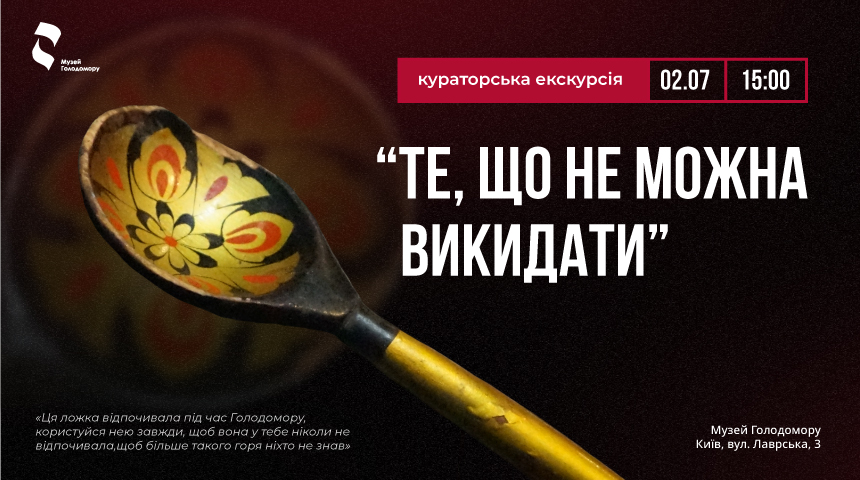Maryna Bohush’s curatorial tour of the exhibition “The things which cannot be thrown away”
“Appreciate life, enjoy it, love each other because, thank God, you are not hungry!!!”. Anastasia Vasyliuk from Mynkivtsi village, Andrushiv district, Zhytomyr region, said these words before she died to her niece Maria Tivodar.
During the Holodomor, she buried her husband and two daughters and carried this pain for the rest of her life. Maria Tivodar told us about the affecting fate of her aunt Nastia.
“In 1933, she did not bury her husband Yakov but only his head, which was thrown by bloodsuckers under the threshold, and the body was eaten. It is not hard to imagine her state, how many tears she cried, staying at that terrible time with three children in her arms: son Vasia and daughters Nina and Vira.
Activists took everything (cattle, arable land), leaving only three buckets of potatoes and a jar of wheat. She did not receive grain or a penny from the collective farm for trudodni (labour days). And how the children were crying when they took the cow out of the barn!!!
She cut down the whole garden for firewood to bake the children a potato per day, and she got by with water or one beet. The children were crying from hunger, and she, petrified, was silent with hunger swellings on her legs.
Soon, girls had such swellings – first on the legs, and then all over the body. Aunt Nastia chewed potatoes, fearing to swallow them, and gave them to the girls, but they could not eat the food and became “calmer”. A month later, they died one after the other at the ages of six and eight. They lay dead on the bench, covered with a blanket The burial place was very close to the aunt’s house, and through the window, you could see how fellow villagers were carrying the corpses of their household members, and she did not have enough strength to carry her daughters because the skin of her legs had cracks, from which liquid was leaking.
A neighbor came to help: he dragged the bodies of the girls into the blanket and threw them with it into a fresh grave dug by someone. It was in the evening, and in the morning, the grave was full of corpses…
And my mother lived with her grandfather – Parfil, who was richer than the others because he had his farmhand, an ox and a plough. At night, he took a cow and a hired man far into the forest, and in the garden, he buried four sacks of wheat under a pile of hay and put a bag of dried pears in the oven. Activists were scrupulous about the “kulak,” they cleared all the barns, taking away oxen, calves, sheep, poultry and all the arable land till the grain. They were looking for the cow, but my mother said that the farmhand had stolen it and disappeared somewhere. Every third night, he brought a bucket of milk from the forest, and our grandfather treated him with crackers.
He and my mother threshed wheat only for “zatyruha” (mash). And for dessert, only my mother got a dry pear as she was breastfeeding the baby, my older brother Vasia. My dad was in the army at the time.
My mother, gathering her strength, went to my aunt late in the evening to share her belongings and a few pears. But she barely recognized her swollen legs…
My mother left her groceries and took Vasia to her grandfather Parfil. The boy was light as a feather, although he was yen years old.
Once, he helped our grandfather skin a dog whose meat was eaten by the whole family, leaving only a piece for my aunt. More than once, my mother mentioned that she had never eaten tastier meat.
Late at night, grandfather went to visit Nastiunia and was very happy that the swellings on her feet had disappeared and she could put on her shoes and walk. He took her with him. That’s how my mother and aunt with their sons Vasylkas remained alive, thanks to the great-grandfather. They never forgot those terrible times of famine. And even now, in my morning prayers, I remember my great-grandfather Parfil, whom I owe my life to. And Aunt Nastia lit candles on several mounds without crosses for many years.”
In the exposition of our exhibition “The things which cannot be thrown away,” you can see a spoon that belonged to Anastasia Vasyliuk. During the Holodomor, it lay idle because there was nothing to eat. Ms Anastasia left a spoon in memory of her niece Maria Tivodar with the words: “This spoon rested during the Holodomor, use it always, so that it never rests with you, so that no one knows such grief again.” Later, the new owner handed it over to the Holodomor Museum.
You can learn more about this and other exhibits during the curatorial tour, which will be conducted by the deputy head of the exhibition and exposition department, Maryna Bohush.
The excursion will be held on Sunday, 2 of July, at 3:00 p.m. (Holodomor Museum, 3, Lavrska Street).
The price is UAH 55 plus an entrance ticket.
Please pre-register using the link: http://surl.li/ihfiz.
